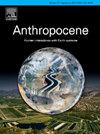Sediment magnetism records of anthropogenic impact on a typical alpine lake in southeastern Tibetan Plateau
IF 3.9
2区 地球科学
Q2 ENVIRONMENTAL SCIENCES
引用次数: 0
Abstract
Alpine lakes provide a valuable opportunity for studying anthropogenic airborne contamination due to the absence of direct human activities in their catchments. However, to date, few in-depth investigations have employed magnetic proxies to assess anthropogenic impacts on these lakes. In this study, we analyzed the magnetic characteristics of a dated sediment core from Lake Jiren, a typical alpine lake in the southeastern margin of the Tibetan Plateau, to elucidate when, how, and to what extent anthropogenic contamination has impacted the lake basin. The results indicate that the magnetic minerals in the core are mainly composed of magnetite, with hematite accounting for a small percentage. In sediments deposited prior to ca. 1933 AD, low values of magnetic concentration-dependent proxies (χlf, χARM, and SIRM) and relatively abundant detrital hematite reflect a dominant input of locally derived magnetic minerals to the lake, implying a relatively pristine environment with minimal anthropogenic impact. The relatively low χARM/χlf and χARM/SIRM ratios indicate coarser magnetic particles, likely resulting from the weathering of the bedrock in the basin. For sediments deposited after ca. 1947 AD, the values of χARM/χlf and χARM/SIRM ratios increased, pointing to a finer size of the magnetic particles. This change, along with the marked increase in SIRM and S-300, suggests an important shift in the source of magnetic particles, indicating a notable anthropogenic contribution—most likely from airborne deposition of anthropogenic magnetic materials over the lake basin, followed by surface runoff to the lake. This transition temporally coincides with large-scale industrial development, such as mining, in southwestern China. A causal relationship is plausible, considering that the magnetic minerals generated by industrial activities have a high potential to be transported to adjacent alpine lakes through atmospheric processes. This study demonstrates that magnetic proxies, which can be acquired rapidly, non-destructively, and cost-effectively, are highly sensitive indicators of anthropogenic airborne contamination in alpine lakes.
青藏高原东南部典型高寒湖泊人为影响的沉积物磁学记录
高山湖泊由于其集水区没有直接的人类活动,为研究人为空气污染提供了宝贵的机会。然而,迄今为止,很少有深入的研究利用磁代用物来评估这些湖泊的人为影响。本文通过对青藏高原东南缘典型的高寒湖泊积仁湖沉积物岩心的磁性特征分析,阐明了人为污染在何时、如何以及在多大程度上影响了该湖盆。结果表明,岩心中磁性矿物以磁铁矿为主,赤铁矿占比较小。在大约1933年以前沉积的沉积物中,低磁场浓度相关指标(χ f、χARM和SIRM)和相对丰富的碎屑赤铁矿反映了主要的本地磁性矿物输入湖泊,这意味着相对原始的环境,人为影响最小。χARM/χlf和χARM/SIRM比值较低,表明盆地基岩的风化作用导致磁性颗粒较粗。对于大约1947年以后沉积的沉积物,χARM/χlf和χARM/SIRM比值增大,表明磁性颗粒的尺寸变小。这种变化,以及SIRM和S-300的显著增加,表明磁性颗粒的来源发生了重要变化,表明了显著的人为贡献——最有可能来自湖盆上空人为磁性物质的空气沉积,然后是地表径流。这种转变与中国西南地区的大规模工业发展(如采矿业)在时间上一致。考虑到工业活动产生的磁性矿物极有可能通过大气过程输送到邻近的高山湖泊,因果关系似乎是合理的。该研究表明,磁指标可以快速、无损、经济地获得,是高寒湖泊人为空气污染的高度敏感指标。
本文章由计算机程序翻译,如有差异,请以英文原文为准。
求助全文
约1分钟内获得全文
求助全文
来源期刊

Anthropocene
Earth and Planetary Sciences-Earth and Planetary Sciences (miscellaneous)
CiteScore
6.30
自引率
0.00%
发文量
27
审稿时长
102 days
期刊介绍:
Anthropocene is an interdisciplinary journal that publishes peer-reviewed works addressing the nature, scale, and extent of interactions that people have with Earth processes and systems. The scope of the journal includes the significance of human activities in altering Earth’s landscapes, oceans, the atmosphere, cryosphere, and ecosystems over a range of time and space scales - from global phenomena over geologic eras to single isolated events - including the linkages, couplings, and feedbacks among physical, chemical, and biological components of Earth systems. The journal also addresses how such alterations can have profound effects on, and implications for, human society. As the scale and pace of human interactions with Earth systems have intensified in recent decades, understanding human-induced alterations in the past and present is critical to our ability to anticipate, mitigate, and adapt to changes in the future. The journal aims to provide a venue to focus research findings, discussions, and debates toward advancing predictive understanding of human interactions with Earth systems - one of the grand challenges of our time.
 求助内容:
求助内容: 应助结果提醒方式:
应助结果提醒方式:


